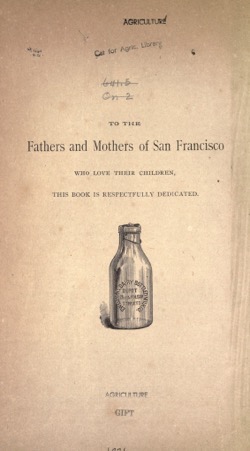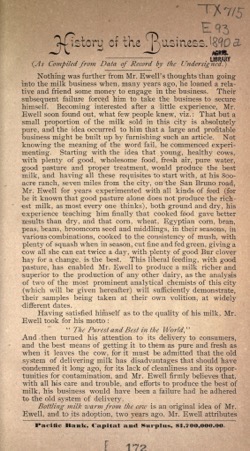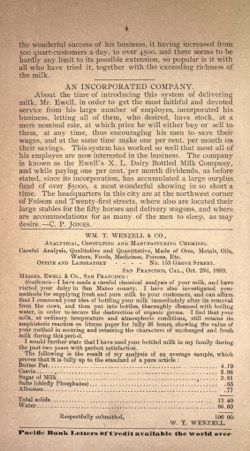Archive.org has a host of old cookery books (from mid-19th to mid-20th Century) available in many formats and on a host of topics. I happened across a few in my Pinterest feed and gone completely down the rabbit hole in this treasure trove of information. Sure some ideas might be out of date, but you never know what you might find when you explore these books. I’ll be sharing more books as I find them in the coming weeks. –Douglas
History of the Business
(As Compiled from Data of Record by the Undersigned)
Nothing was further from Mr. Ewell’s thoughts than going into the milk business when, many years ago, he loaned a rela- tive and friend some money to engage in the business. Their subsequent failure forced him to take the business to secure himself. Becoming interested after a little experience, Mr. Ewell soon found out, what few people knew, viz. : That but a small proportion of the milk sold in this city is absolutely pure, and the idea occurred to him that a large and profitable business might be built up by furnishing such an article. Not knowing the meaning of the word fail, he commenced experi- menting. Starting with the idea that young, healthy cows, with plenty of good, wholesome food, fresh air, pure water, .good pasture and proper treatment, would produce the best milk, and having all these requisites to start with, at his 800- acre ranch, seven miles from the city, on the San Bruno road, Mr. Ewell for years experimented with all kinds of feed (for be it known that good pasture alone does not produce the rich- est milk, as most every one thinks), both ground and dry, his experience teaching him finally that cooked food gave better results than dry, and that corn, wheat, Egyptian corn, bran, peas, beans, broomcorn seed and middlings, in their seasons, in various combinations, cooked to the consistency of mush, with plenty of squash when in season, cut fine and fed green, giving a cow all she can eat twice a day, with plenty of good Bur clover hay for a change, is the best. This liberal feeding, with good pasture, has enabled Mr. Ewell to produce a milk richer and superior to the production of any other dairy, as the analysis of two of the most prominent analytical chemists of this city (which will be given hereafter) will sufficiently demonstrate, their samples being taken at their own volition, at widely different dates.
Having satisfied himself as to the quality of his milk, Mr. Ewell took for his motto :
“The Purest and Best in the World”
Mashed Potatoes.
Old potatoes, when unfit for plain boiling, may be mashed; take off all the
skin and imperfections, and lay them in cold water for one hour; then put
them into a stew-pan with a teaspoon of salt. Cover with cold water and let
them boil for half an hour; take them up with a skimmer into a wooden bowl
and mash them fine. Melt a piece of butter the size of an egg into half a pint
of EWELL’S X. L. DAIRY BOTTLED MILK; mix it with the mashed pota-
toes until it is thoroughly smooth. The quantity of milk must be in proportion
to the quantity of potatoes.
Mashed potatoes may be made a highly ornamental dish. After shaping
it as taste may direct, turn the edge of the plate with a wreath of celery leaves
or green parsley.
Available in PDF, Text, JPG formats, and more





